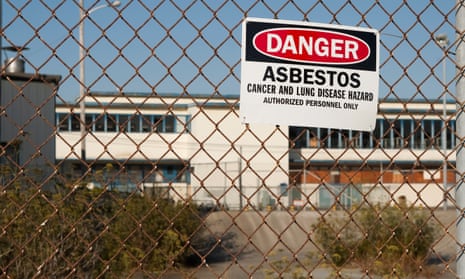A number of public parks have been closed across Sydney after asbestos was detected in mulch at multiple sites.
Friable asbestos was found in mulch at Harmony Park in Surry Hills on Tuesday, where people and their dogs were gathered that morning, while bonded asbestos was found in mulch at Victoria and Belmore parks.
The recent discoveries follow the identification of asbestos at Rozelle parklands, railway substations in Dulwich Hill, Canterbury and Campsie, along the Prospect Highway and at Liverpool public school and Campbelltown hospital.
So, what are the dangers of being exposed to asbestos? And what is the difference between friable and bonded asbestos? Here’s what you need to know.
What is asbestos?
Asbestos is a natural mineral made up of tiny, needle-like fibres that are resistant to heat, electricity and corrosion.
What is it used for?
Asbestos has been used extensively over the last century to make cement sheeting, roofing, drainage pipes, brakes and clutches. In the 1960s and 1970s loose fibre asbestos was used in parts of home roof insulations across NSW.
Australia was one of the largest users in the world until it banned products containing asbestos during the 1990s. A total ban on the mineral did not happen until 2003.
More recently, asbestos has been found in soil or sand substitute and garden mulch containing contaminated building waste.
What does asbestos do to humans?
If asbestos is inhaled into the lungs over a long period of time, it can lead to a form of cancer called mesothelioma – or the chronic lung disease known as asbestosis.
Mesothelioma is caused when asbestos fibres make their way into the mesothelium – the lining that allows your lungs to expand and contract.
“Once the fibres get into that lining they create cancer that is quite volatile, that doesn’t respond to normal treatments for cancer,” Peter Tighe, the independent chair of the Asbestos Industry Research Institute said.
Asbestosis is caused by long exposure to asbestos dust, causing a shortness of breath that worsens with physical activity.
A far less common form of asbestos-related cancer is peritoneal mesothelioma, which is when fibres are ingested into your stomach and infect the stomach lining.
How serious is one-time exposure?
There are actually very small amounts of asbestos in the air we breathe every day which do not cause asbestos-related diseases. If asbestos remains bonded and is left undisturbed, generally you do not need to worry about any significant health risks.
If you are exposed to high levels of friable (airborne) asbestos, it can take decades between exposure and developing asbestos-related illnesses.
after newsletter promotion
People who are diagnosed with mesothelioma have generally been exposed to high levels of asbestos over a long period of time, like tradespeople.
How do you test for asbestos-related illnesses?
Since it can take 15 to 30 years for someone to show symptoms, testing is really difficult.
“We’re not sure whether there is a genetic disposition to it, and to diagnose it properly, when someone does have it, is a very invasive procedure,” Tighe said.
The Asbestos Industry Research Institute is working towards testing people via blood, while training clinicians and nursing staff to recognise asbestos-related cancer more quickly continues.
For the moment though, Tighe said “it’s really difficult to do much about it, other than to record the fact that you’ve been exposed and make people aware of it”.
What if you think you have been exposed to asbestos?
If people are concerned they’ve been exposed to asbestos in the community or at work, they should contact their local council or workplace immediately, to remove any risk.
If you think your home has asbestos, the NSW government strongly recommends contacting a licensed asbestos assessor or removalist.
If you are worried about your health you can visit your GP and privately register with the National Asbestos Exposure Register (NAER). The NAER keeps your records for future reference if you do develop symptoms.
What are the risks of asbestos to animals?
Most experts concentrate on the impacts of asbestos on humans rather than animals, but there is some comfort for those worried about their pets in light of the latest news.
“Given the lifespan of a dog, which is roughly 15 years, it’s unlikely that those animals will be faced with a similar sort of thing here,” Tighe said.
